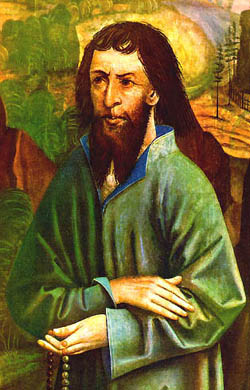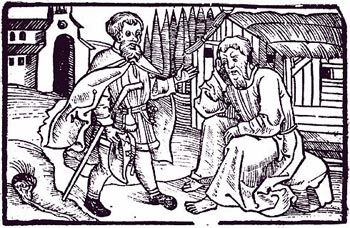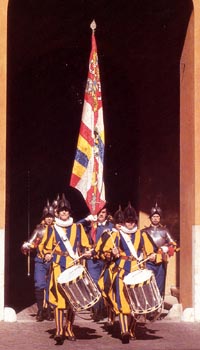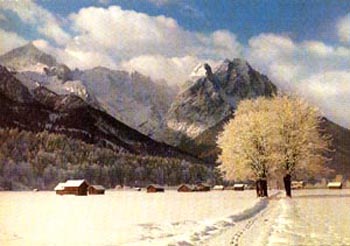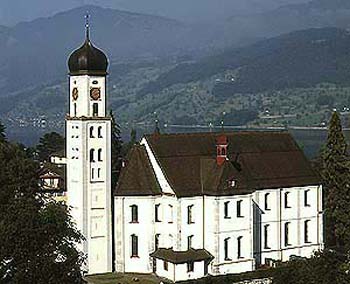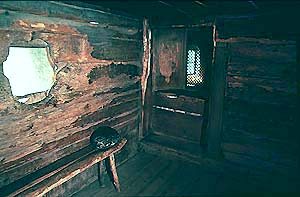Invitation the 23, 24, 25 September 2017, in Flüeli, Sachseln.
Holy Patron of all peaces, world peace, economical peace, peace with elements, human beings, all beings, natural disasters etc, ...
because the love of money is the root of all evils...
The new Catechism of the Catholic Church cites a brief personal prayer of St. Nicholas of Flue in paragraph #226[5] of Chapter 1 of Part 1, Section 2 "The Profession of the Christian Faith" under subheading IV "The implications of faith in one God", an aspect of which is making good use of created things.
Prof. Plinio Corrêa de Oliveira
| Biographical selection: Nicholas was born on March 21, 1417 and died on the same day 70 years later in 1487. He was from the canton of Unterwalden in Switzerland. His parents were simple peasants who tried to provide Nicholas with a better education, given his uncommon intelligence and piety. He had an inclination for the contemplative life and practiced severe mortifications. He married and had ten children, some of whom came to hold high positions in the country. He used to wake every night to pray and read a psalter in honor of Our Lady.
Returning home, he was asked to be mayor of his city, but declined the honor, alleging his humble origin made him unsuitable for that post. However, he accepted the position of judge in the local court, a position that he carried out with rare ability for nine years. Then he retired from this position to his farm to have more time to dedicate himself to matters of the soul. He had received symbolic visions since childhood. After his retirement, he was watching his flock when he mystically saw a marvelous lily growing from his mouth and rising up to the clouds; suddenly it fell to the ground and was eaten by a horse. He understood that his contemplation of heavenly things was often disturbed and consumed by earthly concerns. He realized he should abandon the world and devote himself exclusively to matters of soul as a hermit. Although she had just borne his tenth child, his wife heroically consented. He settled at Ranft, a few miles from his home. From the outset of his life as a hermit, he was miraculously nourished only by the Holy Eucharist, which he received once a month.
Shortly before his death he was assailed by strong pains. “O, how terrible is death!” he used to say. But he delivered his last breath in peace. His body was preserved in the Church of Sachseln, a village close to his birthplace. Even today the visitor can venerate there the bones of Brother Klaus (Nicholas in German), his mortal remains richly ornamented with gold and precious stones, and around his neck countless military decorations of honor. Note: After Vatican II, the richly adorned reliquary, which also served as an altarplace, was replaced with a table and simple modern contemporary tomb without the jewels or military decorations.Comments of Prof. Plinio: To better admire the life of St. Nicholas of Flue, let me propose several presuppositions and make some observations. First, at that time, like today, Switzerland was divided into cantons, which are small provinces. Each canton had an almost complete independence, subordinate only to a Swiss Confederation that exerted a vague authority over them all. They frequently were engaged in disputes and fights, because the neighboring countries exerted different influences over the various cantons. For example, in one canton, they spoke French, in another, German; in another, Italian, etc., and each canton was normally influenced by the neighboring country to which it had culturally closer ties. This generated intense political disputes often followed by military engagements.
Second, you can imagine this valorous man in the battlefield, carrying his sword in one hand, and his shield and rosary in the other. It is a beautiful battle scene! Today you can see how the connotations that surround objects of piety have changed because of sentimentalism. Today, who would say that a rosary reminds one of a warrior? On the contrary, more often it calls to mind a man incapable of fighting. This religious sentimentalism worked an almost complete change. This is a grave injustice to the rosary. Third, it is interesting to see how St. Nicholas showed a profound spirit of hierarchy when he declined an important public post that was offered to him. He said, “No, I am from a humble condition, and I don’t want to exert authority over persons who are higher than me by birth.” Such a thing no longer exists in our century. Today egalitarianism has invaded everything, and we have the opposite: the rejection of someone because he has a higher condition and the preference for the lower. That is, the scale of values has been completely inverted.
You can imagine the scene of the judge Nicholas of Flue seated in the small tribunal of his canton and listening to the different sides of a suit. As the persons are presenting the case, suddenly someone notices that the judge has a distant gaze that reveals he is in ecstasy. He becomes illuminated, seeing a heavenly scene. The talking ceases in the tribunal; the hatred and differences dissolve; when the vision ends the opposed parties are reconciled; the case is resolved. Do you know some judge like this? How everything has changed in our days! You can also imagine the shepherd in the poetic Swiss landscape. In the background are the Alps covered with snow, which at sunset take on pink or light blue hues. St. Nicholas of Flue is there blowing a horn to assemble his dispersed cattle. He stops and prays the Angelus by himself, and then heads toward the stables with the cattle. At this moment he receives the visit of an Angel who shows him Heaven and reveals this or that marvel to him. When he returns, the cattle are all in the stable, quiet and bedded down for the night, led there by another Angel who took care of them. The Angels, the innocence of the Swiss landscape and the soul of St. Nicholas of Flue fit together perfectly. It is something truly superior! Fifth, the vision of the lily that fell and was eaten by an animal showed him that his high contemplation was often destroyed by earthly concerns. If some of us have an analogous problem – and I think that many of us do – we should take St. Nicholas of Flue as our patron saint. We should ask him for the grace to not demean the graces we receive and to sustain our good thoughts. It is encouraging for us to see that saints have the same problem we have.
These are the points I offer for your meditation in admiration of St. Nicolas of Flue, asking him to give us the courage to always have the sword in one hand and the rosary in the other in the difficult fight we are engaged in today. 
The texts of both the biographical data and the comments come from personal notes taken by Atila S. Guimarães from 1964 to 1995. Given the fact that the source is a personal notebook, it is possible that at times the biographic notes transcribed here will not rigorously follow the original text read by Prof. Plinio. The commentaries have also been adapted and translated for TIA’s site. |
Veneration[edit]
He was beatified in 1669. After his beatification, the municipality of Sachseln built a church in his honour, where his body was interred. He was canonized in 1947 by Pope Pius XII. His feast day in the Roman Catholic Church is 21 March, except in Switzerland and Germany, where it is 25 September.
As a layman with family responsibilities who took his civic duties as an ancestral landowner seriously, Brother Klaus is a model of heroic manhood for many concerned with the flourishing of local communities and sustainable use of open land. He is the patron saint of the German-language association KLB (Katholischen Landvolkbewegung), the Catholic Rural Communities Movement.[6]
Visionary images[edit]
Of the many spiritual insights Nicholas received in his visions, one in particular is reproduced often in a reduced logographic format, as a mystical wheel.[7] Nicholas described his vision of the Holy Face at the center of a circle with the tips of three swords touching the two eyes and mouth, while three others radiate outwards in a sixfold symmetry reminiscent of the Seal of Solomon. A cloth painted with the image, known as the meditation prayer cloth[8] associates the symbol with six episodes from the life of Christ: the mouth of God at the Annunciation, the eyes spying Creation both in its prelapsarian innocence and redemption from the Fall at Calvary, while in the inward direction the betrayal by his disciple Judas in the Garden of Gethsamene points to the crown of the Pantocrator sitting in the judgment seat, the glad tidings of the Nativity scene's "Glory to God in the Highest and Peace to his people on Earth" echoes in the ear on the right of the head, while the memorial of the Lord's Supper "This is my body, which will be given for you" at the prayers of consecration in the Divine Liturgy of the Mass echoes to the ear on the left of the head.
These six medallions contain additional symbols of acts of Christian kindness:
- two crutches suggest Visiting the sick as a work of mercy
- hiker's walking stick with travel pouch suggests Hospitality to strangers
- a loaf of bread, fish and a pitcher of water and wine represent Feed the hungry, quench the thirsty
- chains indicate Care for the incarcerated
- Christ's garments evoke Clothe the naked
- a coffin reminds us to Bury the dead
This visual interpretation encapsulates the personal piety of rural peasants, many illiterate, for whom salvation history was expressed in these crucial aspects of God's loving relationship with us and the Christian duty to love of neighbor. Sanctifying grace flows from the Paschal Victim on the Cross, an image Nicholas described in his vision by the stream,[9] where the Tabernacle sits atop a spring that flows forth covering the earth, echoing the rivers flowing from the Temple in Ezekiel's visions. Such profound insights on the allegorical,[10] anagogical and tropological senses of scripture are often lost in modern biblical exegesis that focuses too narrowly on the literal sense, the historical-critical method.
 | Wikimedia Commons has media related to Nicholas of Flüe. |
See also[edit]
- Bruder Klaus Wikipedia page (in German)
- Play Nicolas de Flue written after World War II by Denis de Rougemont (in French)
References[edit]
- ^ a b c d "Blessed Nicholas of Flüe". Catholic Encyclopedia. Retrieved 2008-12-16.
- ^ "Die weisse Lilie und das Pferd" (in German). Retrieved 2008-06-17.
- ^ a b The Saints: A concise Biographical Dictionary, edited by John Coulson, Hawthorn Books, Inc., 1960
- ^ Way of St. James - Being on the way
- ^ Catechism of the Catholic Church - I believe in God
- ^ Wir über uns
- ^ BruderKlaus.com
- ^ JakobusGemeinde.de (in German)
- ^ Webland.ch
- ^ RTF Study Program - Lesson 2: The Four Senses of Sacred Scripture
Further reading[edit]
- Abel, Winfried, “The Prayer Book of St. Nicholas of Flue: Mystery of the Center”, Christiana Edition, Stein Am Rhein, 1999.
- Boos, Thomas, “Nicholas of Flue, 141-1487, Swiss Hermit and Peacemaker”, The Pentland Press, Ltd, Edinburgh, 1999.
- Collins, David J. "Turning Swiss: The Patriotism of the Holy Hermit Nicholas". In Reforming Saints. Oxford: Oxford University Press. 2008. pp. 99–122.
- Jung, Carl Gustav, "Brother Klaus", The Collected Works of C. G. Jung, Bollingen Series XX, Volume 11, Princeton, 1977.
- Kaiser, Lother Emanuel, “Nicholas of Flue-Brother Nicholas: Saint of Peace Throughout the World.” Editions du Signe, Strausbourg, 2002.
- Yates, Christina, “Brother Klaus: A Man of Two Worlds” The Ebor Press, York, England, 1989.
- “Brother Klaus: Our Companion Through Life”, Bruder-Kalusen-Stiftung-Sachseln, 2005.
- "The Transformed Berserker: The Union of Psychic Opposites" The Archetypal Dimensions of the Psyche. von Franz, Marie-Louise. Shambhala, 1997.
External links[edit]
- Tradition in Action, a Roman Catholic hagiography with commentary
- Bruder Klaus page at Sachseln Flüeli-Ranft Tourism Bureau (in German)
- Catholic Encyclopedia article
- Extensive bibliography and link collection
- Photo of his hermitage chapel at KLB Catholic Rural Peoples Movement (in German)
- The "Book" which he read, a discussion of the painted prayer meditation cloth (in German)
- The Lily and Horse from his vision (in German)
- Collection of sentences of spiritual direction (webpage maintained by the Benedictine Abbey "Abbaye Saint Benoît de Port-Valais," at Le Bouveret in Switzerland) (in French)
- Homily of Pope John Paul II at the Mass for Peace, Flüeli (1984) (in French)
